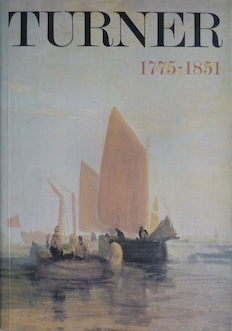|
20 XI 2024 |
4. Success at the Royal Academy 1801-12
098 - ‘Lowther’ Sketchbook - Academy Study of a Female Nude | |

| ||
|
This book contains some pencil studies apparently of Lowther Castle, which Turner visited in the Autumn of 1809; f.26 has the word 'Lowther' written beside some sketches of Gothick details. There are also miscellaneous MS notes and some sketches connected with life on a canal. A series of Academy studies from a female model occurs spasmodically throughout the book. A pencil study of the model in the same pose as in f.40v is on f.46v. The majority of Turner's grand series of compositions - the Rivers and Ports of England, for instance, or the England and Wales views - betray very little overall logic or comprehensive plan; they emerged casually, as it were, from the material by which Turner found himself inspired. The Liber Studiorum is very different. It was conceived from the first as a kind of visual treatise on landscape art, and is the central document of Turner the theorist of painting. Its origins betray the academic purpose he had in mind: it imitates in its title and its medium (etched outline and mezzotint) the famous set of prints by Richard Earlom after the drawings in Claude's Liber Veritatis, published by Boydell in the 1770s (No.B28). Even Turner's careful drawings for the plates, for the most part in sepia or grey monochrome, evoke Claude's landscape studies. This historical allusion at once suggests that Turner was offering his own work in direct competition with that of Claude. But it had a more general purpose. Claude's Liber Veritatis was simply a convenient record made by the artist of all his own compositions, a kind of register of subjects. Turner, it is true, used many of his paintings as subjects for the Liber Studiorum plates; but he did not do so in order to record them - at least, not primarily for that purpose; they contribute to an overall plan, which was to illustrate with suitably designed examples the various ‘branches' into which landscape painting could be divided. This scheme also demonstrated with great clarity the range and variety of Turner's powers, and was therefore an effective advertisement which would reach a far wider public than his paintings ever might. The plates were issued in fourteen parts between 1807 and 1819, each part bearing the title: ‘Liber Studiorum; Illustrative of Landscape Compositions, viz. Historical, Mountainous, Pastoral, Marine, and Architectural'; with the price, 1 guinea for prints, 2 guineas for proofs. Each part seems to have been intended to contain an example of each of the five branches of landscape, but in practice the pattern was somewhat erratic; Turner frequently uses 'E.P.' (probably standing for 'Epic' or 'Elegant Pastoral') as an additional category, at the expense of one of the others. It is, with 'Pastoral', the category which occurs most consistently; and, indeed, is the heading under which Turner's characteristic landscapes seem most naturally to place themselves. The branch in which he is least successful is the 'Pastoral', consisting mainly of rustic genre subjects which do not afford scope for dramatic invention, but of which Turner nevertheless was at pains to demonstrate his mastery (see No.B30). All the parts contained five plates, and No.x, published 23 May 1812, included as an extra plate the frontispiece (No.99) to the whole series which thus comprised seventy-one plates in all. Twenty further designs were not published, though they were wholly or partly engraved, and a number of sketches in brown wash in the Turner Bequest are evidently related to Turner's plans for the work. The transfer of the outlines of the designs on to the plates was generally undertaken by Turner himself, who etched the majority, occasionally using soft-ground, before handing the plate over to the engraver. It seems that at one stage he had envisaged that the Liber would be executed in aquatint, and approached F. C. Lewis, who was engaged in making aquatint facsimiles of Claude's wash drawings; but the two men quarrelled and Turner decided to employ his namesake, Charles Turner, the engraver of his 'Shipwreck' in 1805 (No.B101), and to carry out his project in mezzotint. Charles Turner was responsible for finishing all the plates in the first four parts: thereafter W. Say, R. Dunkarton, G. Clint, T. Lupton and others shared the work with him and with Turner himself, who contributed at least one plate to each of the parts from No.VI onwards. Among the later, unpublished plates are some by him in pure mezzotint, exploring a much richer tone than that commonly found in the earlier plates and anticipating the dramatic effects of the Little Liber (see p.95). This work is also available as a Polaroid. An image generated by an AI Machine Learning Model Property of the artist. | ||
